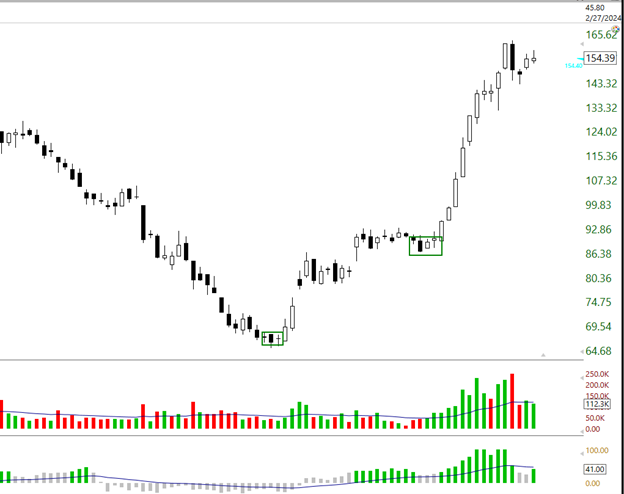–News Direct–
Professional Traders prefer Candlestick charts over all other charting types. Candlestick charts are now the most popular and for good reason. Professionals use Candlestick Buy Entry Signals that are not taught in the traditional Candlestick Books written in the 1990s.
Candlestick Buy Entry Signals are far superior to using only Stock Indicators using crossover entries such as MACD, RSI or Stochastic for buying stocks. Candlestick Buy Entry Signals include the new candlestick patterns that form in the fully automated modern stock market with penny spreads.
Since the professional side of the market controls 80% of all the market activity every day, being able to identify their candlestick footprint in a stock chart enables you to ride the momentum from their huge-lot orders.
Candlestick Pattern Buy Entry signals for the western stock markets and other financial markets are a specific group of candlestick formations that require Relational Technical Analysis to recognize the patterns preceding the Buy Entry Signal.
As an example, a Springboard Buy Entry Signal typically has several Resting-day candles prior to the white Springboard entry signal. This is a highly reliable Buy Entry Signal that frequently forms after a Dark Pool Buy Zone completes and/or after a bottom completion.

This is not an Entry Signal taught in the standard candlestick books. It is a several-day pattern. In the example above, it is a five-day sequence with the size and placement of those five candlesticks making this a strong Buy Entry Signal.
Springboard Entry Signals indicate momentum activity is beginning. In other words: there has been quiet accumulation by Dark Pools over time and this is creating a compression of the stock price. Momentum or Velocity Runs follow the Springboard buy signal. Often HFTs gap up a stock that had a Springboard signal during the bottom development. Why? Because a news event follows a Springboard buy entry signal. Professional traders know about news days before it hits the retail news feeds.
The Springboard is often a sequence of consolidations to runs up that form the Stairstep trendline pattern. These form out of bottoms, sideways trends and trading ranges. The candlestick pattern starts with pro trader setups, which are very small candles with no, or very short, wicks and tails as the professionals are able to control their order and price execution to the penny. This setup often precedes a huge momentum or velocity run which retail traders can learn to use.
Since the professional traders orders are either in Dark Pools or other Alternative Transaction System venues, they are often hidden from intraday level 2 and 3 screens. So learning to see their footprints in the charts is imperative for strong swing trading results.
As a retail trader, your goal should be to learn how to find the best stocks to trade quickly and easily. Often traders spend more time trying to figure out which stock they should trade, or follow retail news, and then buy too late in a run. This can cause whipsaw losses and lowers profits significantly.
The Springboard candlestick pattern is one of many entry signals that are taught exclusively at TechniTrader. This is an extremely reliable Candlestick Pattern for any level of experience. Some of the more advanced patterns are:
-
The Pro Traders Nudge
-
Nesting Candle
-
Push Momentum
-
Hurdle
-
Pole Vault
Note that the names of the Buy Entry Signal candlestick patterns indicate the action of the price movement. Western Candlestick Buy Entry Signals define how a stocks price is most likely going to move next. This is a huge help for all traders, from beginners to Elite semi-professionals.
Learning the basics of candlesticks from the Japanese Candlestick Books is a good place to start. However, if you want to Trade as a Business and make high income from trading stocks, then learning the New Buy Entry Signals is critical to the level of success you can achieve and the income you can make.
In the Modern automated market, the Buy Entry Signals are far superior to the Japanese reversal or continuation candlestick patterns. This is due to the fact that the stock market of the 21st century is totally different from the Japanese rice commodities markets of the 1600s.
Too often, most retail traders use Candlestick Reversal Patterns, Continuation Patterns, MACD, or Stochastic crossovers as entry signals. All of these methods put traders into a stock late with losing trades. They also increase the risk of a whipsaw trade, especially when the Stock Market is in a choppy sideways to volatile Market Condition.
TechniTrader has a mini course you can take that gives you more information about Candlestick Buy Entry Signals for trading stocks. Visit our website to sign up for this free mini course.
Whether you are brand new to trading stocks or you have been trading stocks since the 1990s, learning the New Buy Enty Signals of professional traders will increase your success trading stocks.
Martha Stokes, CMT
https://www.technitrader.courses
TechniTrader has been teaching traders and investors a complete process for trading or investing in the stock market and other financial markets since 1998. We have helped over 500,000 traders and investors achieve their financial goals. Our courses provide a complete, comprehensive training program based on a college-style curriculum that uses a tri-level approach to analyzing assets or derivatives to trade.
Contact Details
Mel Ainuu
Company Website
https://www.technitrader.courses/
View source version on newsdirect.com: https://newsdirect.com/news/the-best-candlestick-signals-for-trading-in-todays-stock-market-575797645
TechniTrader
COMTEX_445571658/2655/2023-12-28T09:14:25
Disclaimer: The views, suggestions, and opinions expressed here are the sole responsibility of the experts. No Smart Herald journalist was involved in the writing and production of this article.